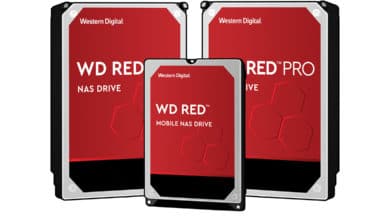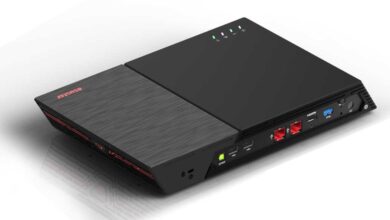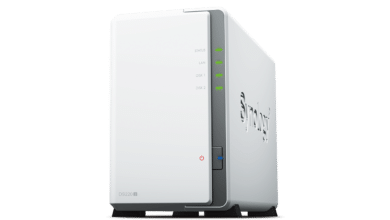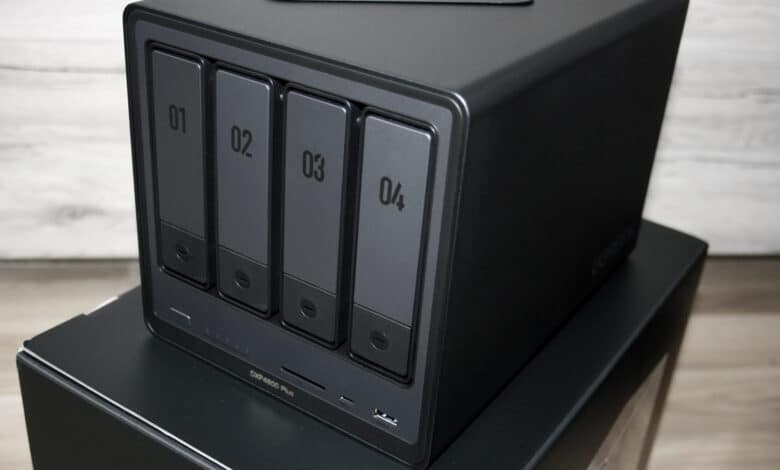
You may already know the manufacturer from various USB accessories or desktop accessories such as stylish notebook stands. And while Ugreen has developed from a non-name manufacturer to a well-known brand in this country, a new product category is already being worked on internally. That’s right, in addition to the well-known network storage systems from Synology and QNAP, a third candidate is now entering the market – with no less than 6 products, all of which have a lot to offer. Because a solid Core i5 (or N100 or Pentium Gold for the entry-level models) and 8 GB of RAM as basic equipment are otherwise only available in sinfully expensive premium models. We have extensively tested the mid-range from Ugreen and would like to share our impressions of the Ugreen DXP4800 Plus with you.
Crowd funding for success
Funding the Ugreen DXP4800 Plus via a crowdfunding campaign on Kickstarter enabled the company to respond directly to the wishes and feedback of potential users. The product and the entire product line were quickly well received, so that the money was raised for development and implementation and the crowdfunding target has already been reached several times over. In the campaign, Ugreen presented the NAS as a powerful but cost-effective solution for data management and storage that is specifically tailored to the needs of small businesses and demanding home users.
This strategy has also helped to build a community around the product. Backers of the campaign often feel part of the project and are more willing to support and promote the product after launch. In addition, the Kickstarter campaign provides a platform where Ugreen can provide regular updates and maintain a direct line of communication with its backers. This helps to build trust and strong brand loyalty, which is invaluable, especially for a relatively new player in the NAS market.
Overview and technical specifications
The Ugreen DXP4800 Plus represents a new challenge in the NAS market. With a robust processor and generous storage, it aims to provide both home users and small businesses with a powerful yet affordable solution. With its product lineup, Ugreen focuses above all on the greatest possible flexibility and expandability. For example, our model can be upgraded to up to 64 GB RAM and equipped with two M.2 SSDs. Together with the 10 Gigabit Ethernet port, the device then achieves extremely high transfer rates, especially if you use the SSDs as cache drives for the intermediate storage of frequently used data or as a buffer for files to be written.
Hardware specifications of the Ugreen DXP4800 Plus
At the heart of the Ugreen DXP4800 Plus beats a 12th generation Intel Core i5 processor, which is supported by 8 GB RAM (DDR5, 4,800 MHz) ex works. This combination offers sufficient computing power for demanding tasks such as streaming media content, performing backups or running virtualization software. And if that’s not enough, you can always easily upgrade the RAM.
The models are also available with various storage options. Our model offers 4 SATA drive bays, which ensures flexible memory expansion. The entry-level models are only equipped with 2 slots. And the professional models have a whopping 8 slots. In addition, Ugreen also offers a so-called all-flash model, i.e. a small housing for up to 4 M.2 SSDs. In terms of network connectivity, our tested DXP4800 Plus has a 2.5 Gigabit Ethernet port and another with 10 Gigabit, which can even be bundled to ensure lightning-fast data transfer within the network.
Comparison with Synology and QNAP
In comparison, Synology offers a similarly positioned model, the DS720, which is also aimed at home users and small businesses. The DS720 comes with a slightly weaker processor, but offers an extensive number of applications and services thanks to the Synology DiskStation Manager (DSM) software. QNAP’s TS-253D, another direct competitor, stands out with similar hardware features, but also has PCIe expansion options that can be used for additional network cards or NVMe SSD caches, for example. However, both competitor products are considerably more expensive, meaning that Ugreen emerges as the price-performance winner in a direct comparison.
Extended product range from Ugreen
In addition to the DXP4800 Plus, Ugreen also offers other models that differ mainly in terms of the processor used. These models are aimed at users with a lower budget or less demanding requirements. While the Intel N100 and Pentium Gold models deliver solid performance for everyday tasks such as file storage and light media streaming tasks, they are not as powerful as the Core i5 model and may reach their limits with more intensive applications such as extensive database management or multiple simultaneous user access.
Our comparison shows that Ugreen’s DXP4800 Plus is an attractive option for users who are looking for a powerful but cost-effective solution without having to sacrifice important functions and a certain degree of expandability. After all, you don’t always need the business features of a Synology or the PCIe slots of a QNAP.
Refreshing design, solidly implemented
The design of the Ugreen DXP4800 Plus is clearly focused on functionality and modern aesthetics. With a robust metal housing that offers both stability and efficient heat dissipation, it stands for durability. The smooth surfaces and sharp edges give the device a professional, timeless look that won’t look out of place in an office or home network. The ventilation system is particularly noteworthy: generous ventilation slots are strategically positioned to ensure optimal air circulation, keeping the hardware cool even during intensive use.
Ease of use during installation and setup
Installing and setting up the DXP4800 Plus is extremely user-friendly. Apart from the locking mechanism, it offers tool-free hard disk bays that facilitate the installation and replacement of drives. This is particularly advantageous for users who want to gradually expand their storage capacity without having to rely on special tools. After all, not every office has a hammer, axe and Phillips screwdriver to hand.
The NAS also supports hot-swap. This means you can replace (defective) drives directly during operation without having to shut down the system. The individual hard disks are placed in easily removable trays. Equipped with a sophisticated mechanism, you can extend the tray outwards, insert the hard disk and close it again. No screws at all and another positive feature: vibration-damping bearings.

The installation tool for your computer is also intuitively designed and comes with a clear and understandable interface that gives even beginners access to all essential and lesser-known functions. A setup wizard guides new users through the initial configuration, from network setup to RAID configuration, and simplifies the setup process to the essential elements.
Cooling system and background noise
An important aspect of the design is the cooling system. The Ugreen DXP4800 Plus uses an intelligent fan that adapts its speed to the system temperature. This not only ensures efficient cooling, but also keeps noise pollution to a minimum. Even under load, the noise of the fan remains discreet, making the NAS ideal for quiet working environments.
When idle, the device is virtually inaudible – but this depends primarily on the hard disks installed. Our test device is equipped with 4 WD Red hard disks, which are definitely much quieter than the Exos series from Seagate, for example. However, as soon as the CPU is challenged a little, for example by updates, fast data transfers in Raid5 or video transcoding, the fan can also do otherwise.
You can also choose between three fan modes in the control panel:
- Standard (automatically adjusts the speed to the temperature)
- Quiet (turns the fan as quietly as possible, but the hardware can get warmer)
- Full throttle (constantly turns to 100% fan speed, nice and cool, nice and loud)
During testing, we noticed that after changing the fan mode, the system may no longer recognize the speed correctly and therefore draws attention to itself with a beep. The only way to stop the alarm is to click on “Acknowledge beep”.
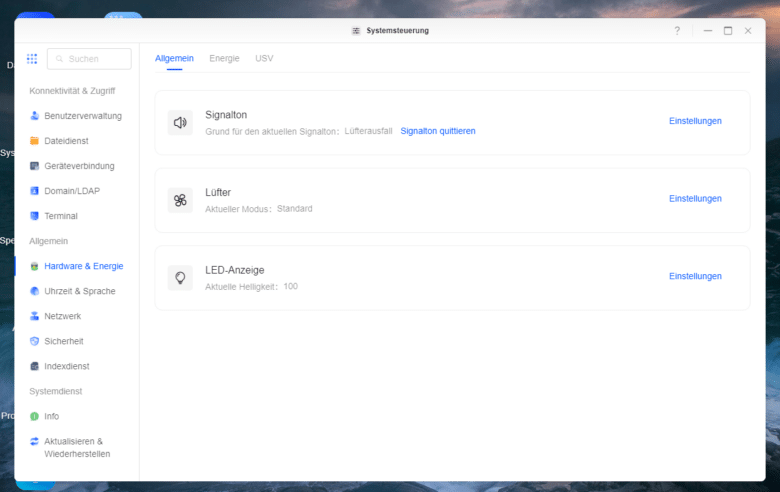
Expandability and connections
The Ugreen DXP4800 Plus has several connections that increase its versatility in everyday office or multimedia use. In addition to the standard network connections, the device also offers USB ports for additional external storage or backup solutions as well as an integrated SD card reader. Although this NAS does not offer the same expandability as some high-end models with PCIe slots, the available options are more than sufficient for most home and office applications.
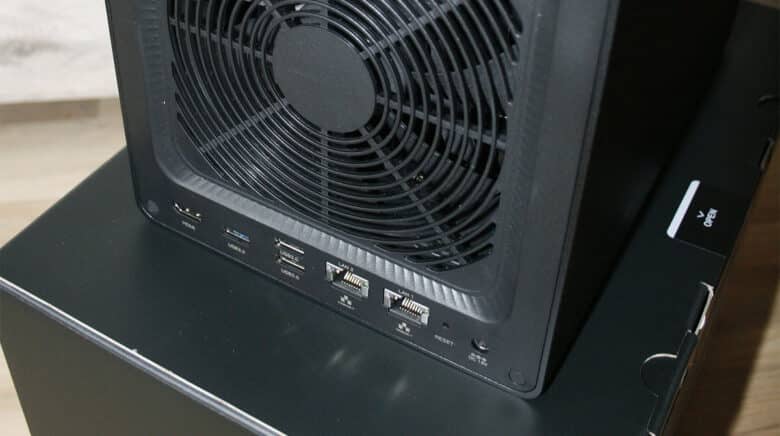
Also worth mentioning is the integrated HDMI port, to which you can connect your TV or projector directly and use the NAS as a media center. The top-of-the-range DXP8800 PLUS model also has two Thunderbolt4 ports on the front of the housing, which you can use to operate additional peripherals. With a little tinkering, you might even be able to connect an external graphics card for extensive video transcoding tasks.
| Connections of the Ugreen DXP4800 Plus | |
| Front | Rear panel |
| SD card reader | 1x 10 GBit/s Ethernet (RJ45) |
| 1x USB Type C Gen 2 (up to 10 GBit/s) | 1x 2.5 GBit/s Ethernet (RJ45) |
| 1x USB3 Gen 2 (up to 10 GBit/s) | 2x USB2 (up to 480 MBit/s) |
| 1x USB3 Gen2 (up to 10 GBit/s) | |
| 1x HDMI (4K @ 60Hz) | |
| Power connection (19 V) | |
It’s the inner values that count: UGOS Pro as a solid operating system
While Synology DSM, QNAP QTS, UnRaid and Proxmox are already established names and big names in the NAS and server sector, Ugreen has cooked up its very own little soup based on Linux. The NAS series is therefore delivered with UGOS Pro. This Linux derivative offers the most user-friendly interface possible. It is also designed to provide a stable and secure environment for day-to-day data management and all other server services. Admittedly, some fine-tuning is still required in some areas, for example the status icons for uploading and downloading are reversed, the fonts are not yet optimally implemented and some translations are somewhat unfortunate. But we assume that Ugreen will get these issues under control.
Memory manager for all kinds of raid configurations
A NAS is usually much more than a simple data storage device and differs from a simple external hard disk in many ways. The Ugreen device is no exception. There are numerous options available to help you store your data as securely and redundantly as possible. If a hard disk dies, no data is lost with the standard configuration.
Immediately after logging in, the NAS therefore suggests creating a so-called storage volume. This is a storage space that uses a raid configuration and combines all the storage space of all installed hard disks. With the recommended default values “Raid5” and “Btrfs” you are already doing quite well. The latter is a file system that automatically recognizes and corrects errors, supports snapshots and offers many other features that an outdated (but still rock-solid) Ext4 does not allow.
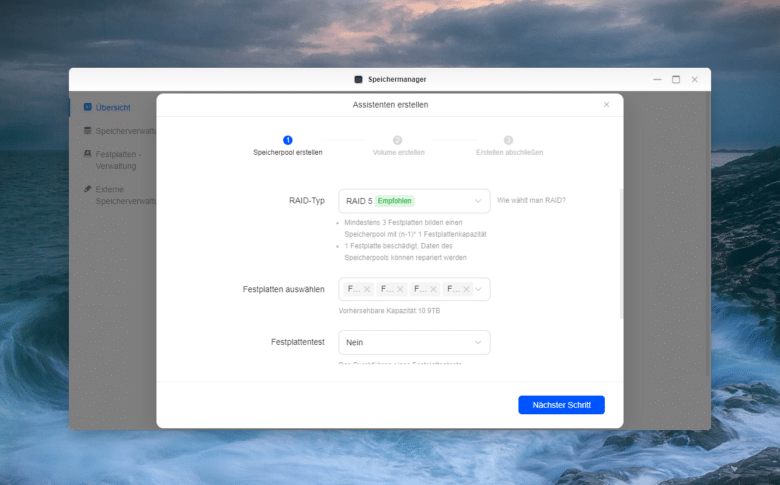
Still few apps, but Docker instead
When calling up the App Center, the central point of contact for expanding the range of functions of your device, there were not yet as many apps available at the time of our test as we were used to from other manufacturers. On the one hand, however, this is not at all surprising, as the product is still being continuously developed. On the other hand, it is not a tragedy because Docker is still available. The latter allows you to either create so-called containers yourself or download and execute pre-configured containers. And these containers can contain anything from the Apache web server to the Plex media center to Zigbee automation. In short, you can easily retrofit all features via Docker, albeit in a roundabout way. This also gives you the advantage that Docker apps are usually updated far more frequently than their NAS counterparts.

Security and backup features of the Ugreen DXP4800 Plus
The Ugreen NAS is already equipped with all security features ex works. With the firewall (deactivated by default), for example, you can choose which services on your network storage can be accessed from outside and which cannot. Individual IP addresses can also be blacklisted via a block list. These can then no longer access your NAS. We assume that a whitelist and the option to select certain IP address ranges will also be integrated in the next updates.
The antivirus app is another practical feature. You can install this as required to protect your Ugreen DXP4800 Plus from viruses and other threats. Integrated backup functions are not yet available. It is therefore recommended that you simply use reliable desktop backup solutions (such as the Windows 11 backup function, Macrium Reflect or EaseUS Backup). The NAS can serve as a secure storage location for your backups. For cross-device and cross-location data backup, synchronization with other cloud storage or an additional NAS is already implemented and opens up another layer of security as part of your 3-2-1 backup strategy.
Management from anywhere: Ugreen Nas app for Android and iOS
While the currently available desktop app is just a minimalist web browser that displays the web interface of the Ugreen NAS, the mobile app is already extremely comprehensive. However, the device cannot be fully operated with it either – some functions simply refer to the desktop app. However, it is pleasant that all relevant status information can be read out and optionally added to the dashboard. The Ugreen NAS app currently only runs in portrait format, but this is not necessarily a problem. And what is not, can still be.
However, the app is not yet available in the official stores. It is only available in the form of an installable file on the manufacturer’s website (Android APK). It is therefore necessary to download the APK file first. You can then install it on your smartphone manually using a file manager or directly via the browser downloads. You may need to activate the installation of apps of unknown origin in the smartphone settings beforehand.
Want to keep an eye on your NAS while you’re on the move? Simply use Ugreen’s own service in conjunction with a Ugreen account. Or opt for a DynDNS provider such as noip.com or duckDNS. This will ensure that your NAS can always be reached via the Internet using a specific address.
The Ugreen DXP4800 Plus: good on the outside, bad on the inside?
Not at all! Our tested NAS offers a solid hardware basis and still has some weaknesses on the software side. But with a product that has only just been launched on the market by a manufacturer that has never developed a NAS before, this is perfectly understandable. Since the device arrived, 4 software updates have already been offered, all of which have brought noticeable improvements. It is therefore not unlikely that Ugreen will continue to optimize its UGOS PRO over time.
If the manufacturer maintains this momentum and continues to listen to the community, nothing stands in the way of a future on a par with giants such as Synology and QNAP. With the increasing maturity of the software and the already strong hardware offering, the DXP4800 Plus could become a reliable, user-friendly and powerful partner for home users and small businesses – with a price-performance ratio that is second to none.
Ugreen DXP4800 Plus
Access times
Transfer rate (read)
Transfer rate (write)
Software & features
Value for money
85/100
The Ugreen DXP4800 Plus offers a hardware selection that is more than above average for NAS and scores particularly well in terms of price-performance. On the software side, however, the manufacturer still needs to make some improvements in some areas. However, for a product that is more or less still in development, this is acceptable.

